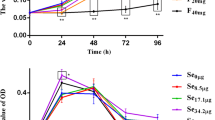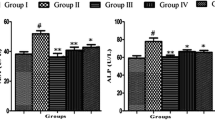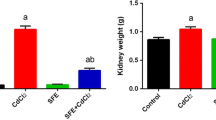Abstract
Curcumin is well known for its potent antioxidant activity. The result of numerous studies showed that antioxidants can protect against fluoride-induced toxicity. In the present study, protective effects of curcumin against sodium fluoride-induced toxicity in rat erythrocytes were evaluated. Curcumin (10 and 20 mg/kg) and vitamin C (10 mg/kg) were administrated intraperitoneally for 1 week followed by sodium fluoride (600 ppm) treatment for next week. Erythrocytes were isolated and superoxide dismutase and catalase activities as well as the levels of reduced glutathione, and lipid peroxidation were measured. The level of malondialdehyde in sodium fluoride treated rats (595.13 ± 20.23 nmol/g Hb) increased compared to the normal rats (315.44 ± 9.76 nmol/g Hb). Animals which were pretreated with curcumin at 20 mg/kg for 1 week prior to sodium fluoride intoxication showed significant reduction in the malondialdehyde level (320.22 ± 9.28 nmol/g Hb). Also, pretreated with curcumin (20 mg/kg) and vitamin C restored the superoxide dismutase and catalase activities and modified the level of reduced glutathione compared with control group (p > 0.01).




Similar content being viewed by others
References
Altuntas I, Delibas N, Sutcu R (2002) The effects of organophosphate insecticide methidathion on lipid peroxidation and anti-oxidant enzymes in rat erythrocytes. Role of vitamins E and C. Hum Exp Toxicol 21:681–685
Bradford MM (1976) A rapid and sensitive method for the quantitation of microgram quantities of protein utilizing the principle of protein-dye binding. Anal Biochem 72:248–254
Chinoy NJ, Patel D (1998) Influence of fluoride on biological free radicals in ovary of mice and its reversal. Environ Sci 6:171–184
Cicek E, Aydin G, Akdogan M, Okutan H (2005) Effects of chronic ingestion of sodium fluoride on myocardium in a second generation of rats. Hum Exp Toxicol 24:79–87
Ellman GL (1959) Tissue sulphydryl group. Ach Biochem Biophys 82:70–77
Esterbauer H, Cheeseman KH (1990) Determination of aldehydic lipid peroxidation products: malonaldehyde and 4-hydroxynonenal. Method Enzymol 186:407–421
Guan ZZ, Wang YN, Xiao KQ, Dai DY, Chen YH, Liu JL, Sindelar P, Dallner G (1998) Influence of chronic fluorosis on membrane lipids in rat brain. Neurotoxicol Teratol 20:537–542
Gul M, Kutay FZ, Temocin S, Hanninen O (2000) Cellular and clinical implication of glutathione. Ind J Exp Biol 38:625–634
Halliwell B, Guttteridge JMC (2007) Free radicals in biology and medicine, 2nd edn. Oxford University Press (Clarendon), Oxford, pp 221–238
Hatcher H, Planalp R, Cho J, Torti FM, Torti SV (2008) Curcumin: From ancient medicine to current clinical trials. Cell Mol Life Sci 65:1631–1652
Jacyszyn K, Marut A (1986) Fluoride in blood and urine in humans administered fluoride and exposed to fluoride-polluted air. Fluoride 19:26–32
Liu SL, Degli Esposti S, Yao T, Diehl AM, Zern MA (1995) Vitamin E therapy of acute CCl4 induced hepatic injury in mice is assisted with inhibition of nuclear factor kappa B binding. Hepatology 22:1474–1481
Mates JM, Gomez CP, Nunez C (1999) Antioxidant enzymes and human diseases. Clin Biochem 32:595–603
Misra HP, Fridovich I (1972) The role of superoxide anion in the autooxidation of epinephrine and simple assay for superoxide dismutase. J Biol Chem 247:3170–3175
Pari L, Latha M (2004) Protective role of Scoparia dulcis plant extract on brain antioxidant status and lipid peroxidation in STZ diabetic male Wistar rats. BMC Compl Alter Med 4:4–16
Rice-Evans CA, Diplock AT, Symons MCR (1991) Techniques in free radical research. Elsevier Science Publishers, Amsterdam, p 200
Rzeuski R, Chlubek D, Machoy Z (1998) Interactions between fluoride and biological free radical reactions. Fluoride 31:43–45
Shan KR, Qi XL, Long YG, Nordberg A, Guan ZZ (2004) Decreased nicotinic receptors in PC12 cells and rat brains influenced by fluoride toxicity—a mechanism relating to damage at the level in post-transcription of the receptor genes. Toxicology 200:169–177
Shanthakumari D, Srinivasalu S, Subramanian S (2004) Effect of fluoride intoxication on lipid peroxidation and antioxidant status in experimental rats. Toxicology 204:219–228
Sharma A, Chinoy NJ (1998) Role of free radicals in fluoride-induced toxicity in liver and kidney of mice and its reversal. Fluoride 31:26–30
Shishodia S, Sethi G, Aggarwal BB (2005) Curcumin: Getting back to the roots. Ann NY Ac Sci 1056:206–217
Shivarajashankara YM, Shivashankara AR, Gopalakrishna BP, Hanumanth RS (2001) Effect of fluoride intoxication on lipid peroxidation and antioxidant systems in rats. Fluoride 34:108–113
Sinha M, Manna P, Sil PC (2007) A 43 kD protein from the herb, Cajanus indicus L., protects against fluoride induced oxidative stress in mice erythrocytes. Pathophysiology 14:47–54
Slater TF (1989) Free radicals in medicine. Free Rad Res Commun 7:119–130
Tilak J, Banerjee M, Mohan H, Devasagayam TPA (2004) Antioxidant availability of turmeric in relation to its medicinal and culinary uses. Phytother Res 18:798–804
Yamagishi SI, Edelstein D, Du XL, Brownlee M (2001) Hyperglycaemia potenciates collagen-induced platelet activation through mitochondrial superoxide overproduction. Diabetes 50:1491–1494
Acknowledgments
The authors acknowledge the financial support of National Elite’s Foundation of Iran (Tehran, Iran) for this study. This paper dedicate to Seyed Maryam Nabavi and with memory of Seyed Ali Asghar Nabavi.
Author information
Authors and Affiliations
Corresponding author
Rights and permissions
About this article
Cite this article
Nabavi, S.F., Nabavi, S.M., Abolhasani, F. et al. Cytoprotective Effects of Curcumin on Sodium Fluoride-Induced Intoxication in Rat Erythrocytes. Bull Environ Contam Toxicol 88, 486–490 (2012). https://doi.org/10.1007/s00128-011-0495-5
Received:
Accepted:
Published:
Issue Date:
DOI: https://doi.org/10.1007/s00128-011-0495-5




